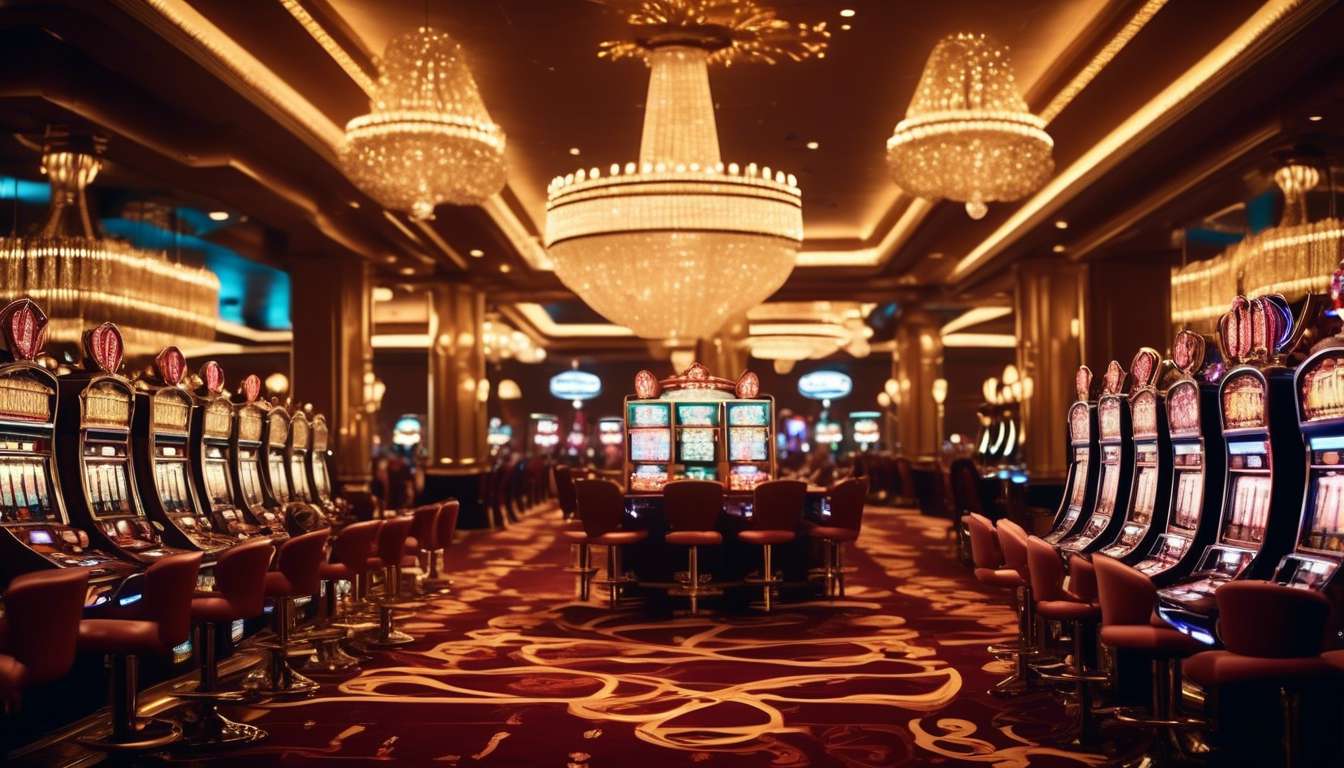As we step into the vibrant world of casinos, we’re immediately enveloped by an atmosphere meticulously crafted to capture our senses and guide our behaviors. The allure of flashing lights, the rhythmic clinking of slot machines, and the inviting scent of indulgence in the air are not mere happenstance.
Together, we find ourselves drawn into this carefully orchestrated environment, where every element, from the layout of gaming tables to the color of the carpets, is designed with precision to influence how we engage with the space. Our collective experience is subtly shaped by these design choices, nudging us towards certain behaviors and spending patterns.
In this article, we delve into the psychology of casino design, exploring how these seemingly innocuous details impact our decisions and interactions. By understanding the strategies employed by casinos, we can gain insight into their powerful influence on our behavior and spending habits.
Sensory Overload in Casino Spaces
Casinos often bombard us with a mix of bright lights, vibrant colors, and constant noise to keep us engaged and spending. This sensory design isn’t accidental; it’s a calculated strategy aimed at influencing our player behavior.
As we navigate the casino layout, each element is meticulously crafted to create a sense of excitement and community. It’s as if we’re all part of a shared experience, drawn together by the allure of potential winnings and the thrill of the game.
We notice how the sensory overload subtly nudges us to stay longer and play more. The strategically placed machines, the inviting sounds of jackpots, and the enticing visuals all work together in harmony. They evoke a sense of belonging, making us feel like we’re part of an exclusive club, where time slips away and the outside world fades.
In this immersive environment, our senses are heightened, and we become part of the vibrant tapestry of the casino experience.
The Impact of Lighting Choices
Lighting in casinos subtly manipulates our emotions, creating an atmosphere that encourages us to linger and play. Through strategic sensory design, lighting choices shape our experiences and influence our player behavior.
As we step into the casino layout, the soft, warm lights provide a welcoming glow, making us feel at ease and part of something bigger. This deliberate design enhances our sense of belonging, drawing us deeper into the gaming environment.
We notice that brighter areas highlight exciting games and dynamic spaces, urging us to explore and engage. Meanwhile, dimmer corners offer a sense of privacy, inviting us to stay longer and fostering a sense of personal space within the bustling casino.
The interplay of light and shadow isn’t random; it’s crafted to guide our journey through the casino, affecting our decisions and, ultimately, our spending.
By understanding these lighting strategies, we can appreciate the subtle ways casinos create inviting spaces that both captivate us and influence our gaming behavior.
Soundscapes and Their Influence
Soundscapes in casinos subtly shape our emotions and actions, making us more inclined to stay and play. We often find ourselves enveloped in a carefully curated auditory environment, where the sensory design is not just an afterthought but a strategic element.
Key auditory elements include:
- The sounds of coins clinking
- Slots whirring
- Distant cheers
These sounds create an atmosphere of excitement and possibility. This deliberate auditory backdrop influences player behavior, encouraging us to feel like part of an exhilarating community where luck could strike at any moment.
In the casino layout, soundscapes are meticulously crafted to maintain our engagement and entice us deeper into the gaming floor. Soft background music and ambient sounds mask the passage of time, allowing us to lose ourselves in the moment and fostering a sense of belonging.
By manipulating sound, casinos create an inviting environment where we feel connected to others, subtly guiding our decisions and enhancing our overall experience.
Together, these elements ensure we remain captivated and entertained.
Layouts: A Strategic Approach
In most casinos, the layout is strategically designed to maximize player engagement and optimize the flow of movement.
We find ourselves drawn into spaces that feel both inviting and exhilarating, thanks to thoughtful sensory design. The way a casino layout is crafted plays a crucial role in influencing player behavior. By creating a seamless flow, we’re naturally guided through an immersive experience, where our senses are stimulated at every turn.
As we navigate these spaces, the layout subtly encourages us to explore every corner, ensuring we don’t miss out on any exciting opportunities. This sense of belonging is amplified when a casino layout fosters a community-like atmosphere, where players feel at ease and connected to the environment.
The intentional use of sensory design elements encourages us to linger, socialize, and engage more deeply with the games and fellow players. These elements include:
- Lighting: Carefully designed to enhance the ambiance and focus attention.
- Sounds: Engaging audio that adds excitement and draws players into the experience.
- Spatial arrangements: Layouts that promote interaction and exploration.
Together, these strategies create an environment where we all feel welcome and eager to participate.
Color Psychology in Casino Design
Colors play a pivotal role in influencing our emotions and behaviors within a casino environment. When we step into a casino, the hues surrounding us aren’t chosen randomly; they’re part of a strategic sensory design aimed at enhancing our experience.
Warm, inviting colors like reds and golds often dominate because they evoke excitement and energy, encouraging us to stay longer and potentially spend more.
- Reds: Evoke excitement and energy.
- Golds: Create a sense of luxury and warmth.
Blues and greens, on the other hand, create a calming effect, helping to soothe our minds and keep us focused on the games.
Incorporating color psychology into the casino layout is essential for shaping player behavior. It’s about crafting an atmosphere where we feel comfortable and engaged, fostering a sense of belonging among players.
By strategically placing different colors throughout the casino, designers guide us through various areas, subtly influencing our decisions without us even realizing it.
This thoughtful design enhances our experience, making the casino not just a place to play, but a space where we feel at ease.
The Role of Comfort and Ergonomics
Comfort and ergonomics play a vital role in keeping us relaxed and engaged during our gaming experience. When casinos prioritize sensory design, we feel more at home, enabling us to focus on the thrill of the game.
The casino layout is meticulously crafted to ensure that everything from seating to lighting aligns with our natural movements and preferences. This thoughtful design approach enhances player behavior, encouraging us to stay longer and, ultimately, spend more.
We find ourselves drawn to environments where we feel a sense of belonging. Casinos that pay attention to ergonomic details, such as:
- Comfortable chairs
- Accessible gaming tables
create an inviting atmosphere. These elements act as subtle cues that tell us we’re valued and welcome.
When we feel physically at ease, our minds are free to immerse in the gaming experience, heightening our overall enjoyment. By considering our comfort, casinos craft spaces that resonate with our desire for community and connection.
Unveiling the Effect of Architecture
Architecture profoundly shapes our casino experience by influencing how we navigate and interact with the space. The casino layout isn’t just a random arrangement of tables and machines; it’s a carefully crafted environment that subtly impacts player behavior.
Sensory Design and Player Movement
As a community of players, we find ourselves drawn into the intricacies of sensory design that guide our movements and decisions. When we step inside, the layout invites us to explore further, directing us along paths designed to maximize both our comfort and engagement.
Strategic Placement of Games and Amenities
The strategic placement of games and amenities ensures that we encounter a mix of excitement and relaxation as we move through the space. This sense of belonging is cultivated through thoughtful design elements that make us feel part of a larger, vibrant community.
Impact on Player Experience and Spending
By understanding how these architectural choices affect us, we can appreciate the seamless way casinos create a welcoming atmosphere. This enhances our overall experience and, inevitably, influences our spending habits.
Signage and Behavioral Cues
Signage plays a crucial role in guiding us through the casino, subtly steering our decisions and enhancing our overall experience.
As we navigate the intricate casino layout, well-placed signs offer us:
- A sense of orientation
- A feeling of belonging
- An engagement with the vibrant environment
These signs aren’t just about directions; they’re about creating a sensory design that engages us on multiple levels. Bright colors, strategic fonts, and clever symbols all work together to influence player behavior without us even realizing it.
When we talk about sensory design, we’re referring to the way signage interacts with our senses, creating an atmosphere that feels both exciting and welcoming.
Effective signage can:
- Lead us to high-traffic areas
- Gently nudge us toward less crowded spaces
- Impact our choices and spending patterns
By understanding the subtle cues embedded in the casino layout, we can appreciate how these elements create an inclusive space where we’re all part of the action.
Conclusion
In conclusion, the design of a casino plays a crucial role in shaping player behavior and spending habits.
From sensory elements like lighting and sound to strategic layouts and color psychology, every aspect is meticulously crafted to create a specific atmosphere.
Comfort, architecture, and signage also contribute to the overall experience.
Understanding how these design choices influence players can help casinos optimize their spaces for maximum engagement and profitability.

